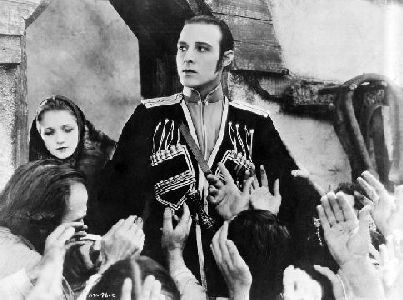The Eagle (1925) 

Director: Clarence Brown
Cast: Rudolph Valentino, Vilma Bánky, Louise Dresser
Synopsis: A wanted Russian lieutenant becomes a masked vigilante seeking vengeance upon the man who stole his family’s land, only to fall for his charming daughter.
Latin lover Rudolph Valentino’s career was suffering something of a slump when he came to make The Eagle, a loose adaptation of an Alexander Pushkin story, in 1925. His previous two movies, Monsieur Beaucaire and A Sainted Devil, his last for Paramount, had both provided lacklustre returns at the box office, and it was obvious that, while Valentino was still a major draw for the ladies, he failed to attract male viewers in the way that action heroes like Douglas Fairbanks did. So The Eagle was Valentino’s attempt to muscle in on that market. In a perhaps misguided attempt to appeal to both genders, the ads proclaimed The Eagle was ‘As rapacious as an eagle as a bandit, as soft as a woman when the heart rules, this ideal lover Rules Supreme,’ making him sound more like a greedy wimp than an action hero, but the film was pretty good, and Valentino acquitted himself well.
He plays Lieutenant Vladimir Dubrovsky, a Cossack serving under the Czarina Catherine II (Louise Dresser — an inspired piece of casting), who catches her eye when he hijacks her horse to catch a runaway carriage in which Mascha Troekouroff (Vilma Banky) and her Aunt Aurelia (Carrie Clark Ward) are travelling. The Czarina summons Dubrovsky to her rooms that evening, not to reprimand him for riding off on her horse, but because she has a major case of the hots for the dashing young officer. Just how badly she fancies him is evident from the way she swoons when he kisses her hand. Dubrovsky isn’t too keen, however; she might be his ruler, but she’s also a middle-aged woman, so when she briefly departs to slip into something more comfortable (but definitely less flattering) he seizes the opportunity to make his getaway, irrespective of the warning of his friend and fellow officer, Kuschka (Albert Conti), that to do a runner could have serious repercussions.
Dubrovsky’s moment of moral outrage couldn’t have come at a worse time, however, because he arrives back at his quarters to find a letter from his father, explaining that he has been cheated out of his property and money by a scheming neighbour named Kyrilla (James Marcus) operating in league with a corrupt district judge (George Nichols). Dad makes it clear that he’s relying on his son’s influence with the Czarina to get him out of the hole he’s dug for himself, so Dubrovsky has no choice but to return to the Czarina with his tail between his legs. However, by the time he returns to the Czarina’s palace the word has already gone out that he is to be apprehended dead or alive for desertion, and is therefore forced to make his getaway for the second time that night.
Dubrovsky returns home only to find that his father has died, and vows to get his revenge on Kyrilla, whom he holds responsible. He also determines to help those who fall prey to Kyrilla’s exploitation by adopting the persona of The Black Eagle, a fearless Robin Hood figure who robs Kyrilla’s henchmen and returns their spoils to their rightful owners. One day, a few of the Eagle’s men kidnap Kyrilla’s daughter, who happens to be no other than the fetching maiden Dubrovsky saved in that runaway carriage, which complicates things a little because Dubrovsky was smitten with her the first moment he laid eyes on her. Because Mascha despises the Black Eagle for the way he’s tormenting her father, Dubrovsky adopts a second disguise, that of a French teacher hired by Kyrilla to teach the language to his daughter, in order to get close to her.
The Eagle — it dropped the ‘Black’ to avoid confusion with Fairbanks’ The Black Pirate, which was in production at the same time as this movie — is a great looking movie which benefits from fine camerawork from George Barnes and an un-credited Devereaux Jennings and nice set decoration from William Cameron Menzies. It has to be said, though, that it plays fast and loose when it comes to evoking the look of 18th Century Russia — we’re never in any doubt that what we’re watching is taking place in 20th Century California, and Vilma Banky’s costumes and hairstyle make no concessions to the period in which the story is supposed to be taking place.
But then, movies like this weren’t about historical accuracy so much as they were about delivering a touch of romance and adventure into movie-goers lives, and this The Eagle does with aplomb. The early action sequences, in which Dubrovsky jumps from the Czarina’s horse onto the back of one of the runaway horses pulling Mascha’s carriage, were reportedly performed by Valentino, but I’m a little sceptical about that to be honest. I can’t help thinking that if a major star was performing his own stunts, the director — even a first-timer like Clarence Brown — would be sure to capture a few shots which make it clear that’s his leading man up on the screen, but we never get a clear shot of the rider’s face as far as I can recall. Nevertheless, The Eagle provides some great escapist entertainment, and Valentino makes a dashing leading man. I can’t help wondering what happened to that genuine French tutor whose identity Dubrovsky assumed, however…
(Reviewed 8th December 2013)
httpv://www.youtube.com/watch?v=P3xH8VmVmUY
